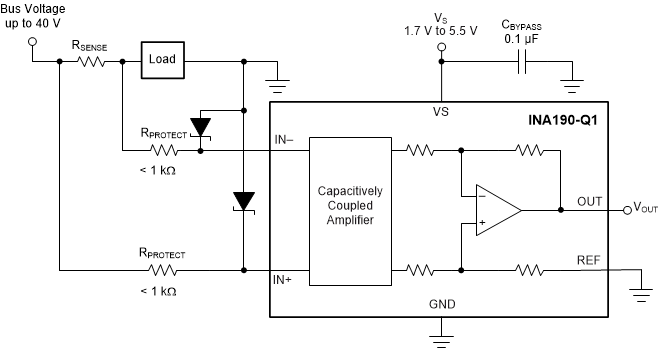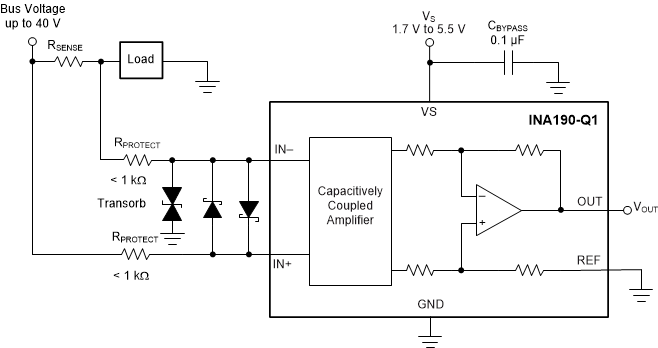ZHCSJT2A May 2019 – March 2022 INA190-Q1
PRODUCTION DATA
- 1 特性
- 2 应用
- 3 说明
- 4 Revision History
- 5 Pin Configuration and Functions
- 6 Specifications
- 7 Detailed Description
- 8 Application and Implementation
- 9 Power Supply Recommendations
- 10Layout
- 11Device and Documentation Support
- 12Mechanical, Packaging, and Orderable Information
8.1.4 Common-Mode Voltage Transients
With a small amount of additional circuitry, the INA190-Q1 can be used in circuits subject to transients that exceed the absolute maximum voltage ratings. The most simple way to protect the inputs from negative transients is to add resistors in series to the IN– and IN+ pins. Use resistors that are 1 kΩ or less, and limit the current in the ESD structures to less than 5 mA. For example, using 1-kΩ resistors in series with the INA190-Q1 allows voltages as low as –5 V, while limiting the ESD current to less than 5 mA. If protection from high-voltage or more-negative, common-voltage transients is needed, use the circuits shown in Figure 8-4 and Figure 8-5. When implementing these circuits, use only Zener diodes or Zener-type transient absorbers (sometimes referred to as transzorbs); any other type of transient absorber has an unacceptable time delay. Start by adding a pair of resistors as a working impedance for the Zener diode (see Figure 8-4). Keep these resistors as small as possible; most often, use around 100 Ω. Larger values can be used with an effect on gain that is discussed in the Section 8.1.3 section. This circuit limits only short-term transients; therefore, many applications are satisfied with a 100-Ω resistor along with conventional Zener diodes of the lowest acceptable power rating. This combination uses the least amount of board space. These diodes can be found in packages as small as SOT-523 or SOD-523.
 Figure 8-4 Transient
Protection Using Dual Zener Diodes
Figure 8-4 Transient
Protection Using Dual Zener DiodesIn the event that low-power Zener diodes do not have sufficient transient absorption capability, a higher-power transzorb must be used. The most package-efficient solution involves using a single transzorb and back-to-back diodes between the device inputs (see Figure 8-5). The most space-efficient solutions are dual, series-connected diodes in a single SOT-523 or SOD-523 package. In either of the examples shown in Figure 8-4 and Figure 8-5, the total board area required by the INA190-Q1 with all protective components is less than that of an SO-8 package, and only slightly greater than that of an VSSOP-8 package.
 Figure 8-5 Transient
Protection Using a Single Transzorb and Input Clamps
Figure 8-5 Transient
Protection Using a Single Transzorb and Input ClampsFor more information, see the Current Shunt Monitor With Transient Robustness reference design.